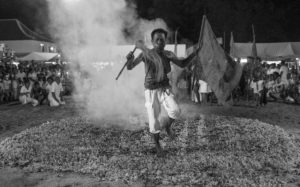Ritualistic walking on burning coals is one of the popular rites that is still observed in many places. In ‘Tabbaliyu Neenade Magane’, too this ceremony takes place. The ritual is also described elaborately in ‘Nayi-Neralu’. This is a ritual that is conducted once a year, in front of the temple dedicated to the Goddess. Many people take religious vows to walk on live coals, and pray to the goddess for fulfilment of their wishes. In ‘Nayi-Neralu’, Acchyuta’s wife Kaveri, who did not have children, had to go through this ritual with the belief that it would ward off the curse of Acchannayya and Venkamma. Usually, this ceremony is conducted during the festival dedicated to the Goddess. Bhyrappa describes in great detail the arrangements made in preparation for this ceremony. Around twenty cartloads of firewood are gathered and ignited in the place prepared for it, in front of the temple. People who have come from the surrounding villages gather around the place. After the wood has burned down completely, the servants of the Goddess evenly spread out the glowing embers. Devotees who had taken the vow of walking on live coals, bathe in a pond by the temple and come in a procession along with the priest. Drums are beaten in a wild frenzy, rhythmically, and some even dance in ecstasy. His head fully smeared with kumkum, the priest enters and stands near the burning coal. He then summons people who have taken the vow. Hundreds of people stand behind the man carrying the idol of the Goddess. The man then rushes into the pit with the burning coal. The drummer beats the drum incessantly and all the others follow the priest. The man carrying the idol of the Goddess then walks thrice on the fire and all the others follow. Finally, people who had not taken any vows also walk on the fire. Meanwhile, the priest becomes possessed by the Goddess and the ritual of asking questions of the Goddess and praying to her begins. The Goddess provides cryptic answers to the questions of the devotees (Page 143-145 ‘Nayi-Neralu’). It is believed that nobody is hurt by the fire.
These rituals, ceremonies, religious rites, myths and legends are the results of social, spiritual and psychological experiences of generations, starting from early human life and civilisation. As such, their presentations make us aware of the cultural ethos, and the growth of civilisation. At the same time, it goads us to think about the latent power of these ageless ceremonies, which have survived till today and are carried out even in this so-called scientific age.
The theory of karma:
It is inevitable that one will reap what one sows - this is the main principle of karma and this is shown through Acchannayya’s actions and their consequences in the novel ‘Nayi-Neralu’. Acchannayya invites a sanyasi to his house with the hope that he will bless him with progeny. He asks him for something as guarantee that his blessings will bear fruit. The sanyasi gives Achhannayya his big staff and tells him to safeguard it. Acchannayya becomes curious about the weight of the staff, and opens it at night. Finding it filled with gold coins inside, an evil thought enters his mind. He replaces the gold coins with discs of iron and puts the gold coins in his wooden chest. Through this evil act Acchannayya trespasses the three ethical rules or codes. Firstly, it was a breach of trust, secondly, he did this to the sanyāsi who had come to his house as a guest, and thirdly, he did it although the sanyāsi had promised to bless him with a child. The sanyāsi came, performed some rituals, took his staff and went away. It is inevitable that the karma or actions of men should have their consequences, one day or other. Vishweshwara is the child born to this couple. He, too, gets married and begets a son. But he did not get to see his son, as the child was born under the star Moolanakshatra. In his twenty-fourth year, Vishweshwara goes to the Kumbhamela, visits a shop owned by a seth (a businessman) gives him money, and reminds the seth of his old loan to the sanyāsi. Vishweshwara then asks the old seth to declare that the debt has been repaid. He then goes straight to the sangam and drowns there. Retribution for the actions of Acchannayya begin to work now. The same Vishweshwara is born as a son to Thirumala Jois, he is again reunited with his parents and wife from his previous birth, and is sent to jail by his own son from the previous birth. After coming out of jail he leaves everybody and goes away like a sanyasi, and his cycle of karma is complete. Acchannayya has to pay for his deeds in his old age. After his son’s death, he had got the dome of the temple covered with gold. This might have mitigated his sense of guilt, but it could not absolve him of his sin. Only when he confesses his past deeds before the sanyasi, who had come to Jogigudda, is he redeemed. He, too, leaves with the sanyasi. Acchyuta is cursed by his mother and grandfather for his lack of faith, and remains childless. Thus, myths, rituals, the theory of karma and rebirth are intertwined in the plot and make it sometimes mysterious, sometimes incredible and sometimes as complex as the theories that work behind them. The belief that one ought to repay one’s debts either in the present birth or in the next birth, which has almost become a myth, is presented here.
The various facets of the tradition of adoption at present are treated from the social, economic, emotional and psychological points of view in ‘Nirakarana’. Given that it is not possible to recreate the myth of ‘Niyoga’ of Mahabharata, and in an age where other modern scientific methods were not yet popular, adopting a child was the only way for childless couples to find outlets for their parental feelings. The tradition of adoption has become popular these days. Along with this tradition that deals with attachment and feelings between parent and child, the myth of real sanyāsa or detachment in life is also depicted. These two create a tension in the novel. While the myth of real sanyāsa is explored in the depiction of Barah-maasi Maharaj, emotional struggles, spiritual aspirations and the pull towards life are all concretised in Narahari. Through Narahari, who becomes Nissangananda and ascends the Himalayan mountain ranges, visiting places of pilgrimage like Hrishikesh, Kashi, Gaya, Triveni Sangam, Kedar and
others, the myths and legends concerning them are depicted. In popular belief, Uttarakhand is considered to be the land of good deeds. No other place is as holy as this for performing penance, and it is as sacred as Prayāga. Gowrikunda, with its hot water spring, is a natural wonder. According to the mythical story the Goddess Gowri bathes in this spring and that is why the water is hot, and hence the name ‘Gowrikunda’. Whereas the water of this pond is almost at boiling point, in another part of the place, there is cold water. At places like this, wonderful phenomena of nature and mythology are fused. The Himalayan mountain range itself evokes a sense of devotion, grandeur and spiritual aspiration in the mind of an Indian. The sheer whiteness of ice is attractive and repulsive to people who are still full of feelings, emotions and passions. But a sanyāsin like Barah-maasi Maharaj walks naked, and comfortably, in the sheer heights and amidst the monotony of the whiteness of the Himalayan ranges. He does not need oxygen cylinders, or special clothing or boots like modern mountain climbers. He is a metaphor for the mountain itself, and embodies the concept of oneness with nature in all its aspects. In Barah-maasi Maharaj, the myth of Siddhas and real sanyasis is concretised. Feeding a sanyasin is considered to be a good deed in India, and the pilgrims in ‘Nirakarana’, too, follow this as a vrata. The myth of sanyasa and sanyasis is a never dying tradition in India.
Along with these serious motifs, ‘Nirakarana’ presents a legend, which is a combination of folklore, mythology and humour - the legend of tobacco. Ramakrishna tells this story when Narahari wants to get rid of his habit of using tobacco. Ramakrishna declares that tobacco means prostitute, and who ever uses tobacco, commits the sin of going to a prostitute. The story runs like this: The creator Brahma fathered a girl child. As he is the one who writes everybody’s fate, he wanted to write a special destiny for his daughter. On the third day after the birth of the child, Brahma went into the chamber where the mother and child were sleeping, and wrote ‘extremely clever’. But by the slip of the hand, in that dark room, he wrote ‘extremely whore’. (in Kannada the words are 'kadu-jaane' and 'kaadu-jaare'). It was not possible for him to correct it. The girl grew up. Brahma was worried about the destiny he had written for her. Thinking that Agni, who would burn everything with his power, could help, Brahma gave his daughter in marriage to Agni. But, whenever Agni went to the earth to receive his ‘havis’, his wife made friends with lndra. Through the friendship of Rambha, Urvashi and others, this lady became very bold and began to commit adultery with many people. When Agni came to know of this, he burnt her to ashes. Then her soul or being went to Yama. When Yama could do nothing; Brahma created a beautiful body for his daughter and Yama himself married her. Whenever Yama left his abode to inquire about the good and bad deeds of people, his wife used to resort to her old games. Her friends, who were angels and therefore invisible, would come to her place unnoticed and vanish in the same way. One day, she was caught red handed by Yama, and he sent for his father-in-law. Then Brahma came and realised that his daughter was incorrigible and cursed her to be born as tobacco on earth, and to serve people in the form of beedis, cigarettes, snuff, tobacco etc. This was the story that Ramakrishna’s grandmother had told his mother. Whether this is a mythical story or not, it lightens the mood of the novel, and adds humour.















































